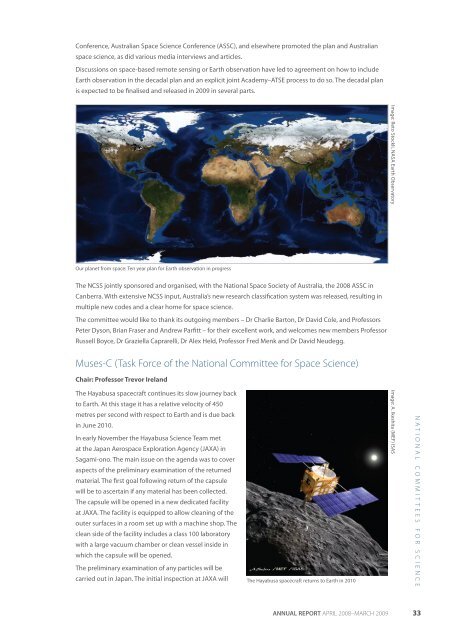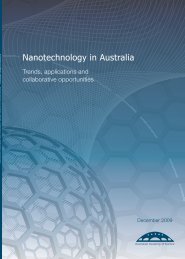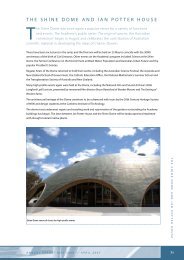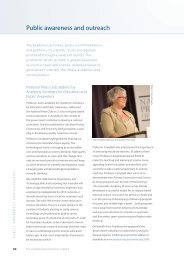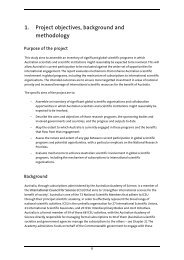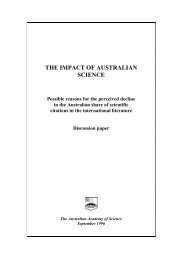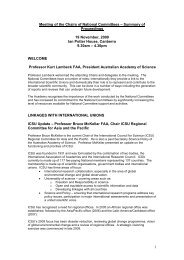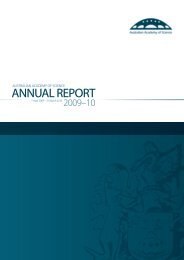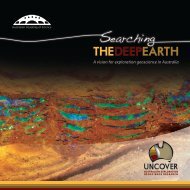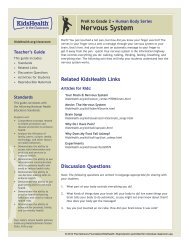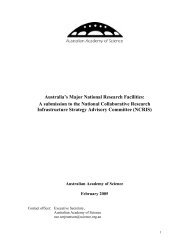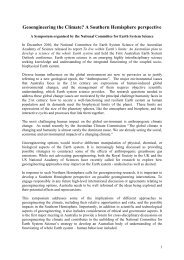full report - Australian Academy of Science
full report - Australian Academy of Science
full report - Australian Academy of Science
Create successful ePaper yourself
Turn your PDF publications into a flip-book with our unique Google optimized e-Paper software.
Conference, <strong>Australian</strong> Space <strong>Science</strong> Conference (ASSC), and elsewhere promoted the plan and <strong>Australian</strong><br />
space science, as did various media interviews and articles.<br />
Discussions on space-based remote sensing or Earth observation have led to agreement on how to include<br />
Earth observation in the decadal plan and an explicit joint <strong>Academy</strong>–ATSE process to do so. The decadal plan<br />
is expected to be finalised and released in 2009 in several parts.<br />
Image: Reto Stockli, NASA Earth Observatory<br />
Our planet from space: Ten year plan for Earth observation in progress<br />
The NCSS jointly sponsored and organised, with the National Space Society <strong>of</strong> Australia, the 2008 ASSC in<br />
Canberra. With extensive NCSS input, Australia’s new research classification system was released, resulting in<br />
multiple new codes and a clear home for space science.<br />
The committee would like to thank its outgoing members – Dr Charlie Barton, Dr David Cole, and Pr<strong>of</strong>essors<br />
Peter Dyson, Brian Fraser and Andrew Parfitt – for their excellent work, and welcomes new members Pr<strong>of</strong>essor<br />
Russell Boyce, Dr Graziella Caprarelli, Dr Alex Held, Pr<strong>of</strong>essor Fred Menk and Dr David Neudegg.<br />
Muses-C (Task Force <strong>of</strong> the National Committee for Space <strong>Science</strong>)<br />
Chair: Pr<strong>of</strong>essor Trevor Ireland<br />
The Hayabusa spacecraft continues its slow journey back<br />
to Earth. At this stage it has a relative velocity <strong>of</strong> 450<br />
metres per second with respect to Earth and is due back<br />
in June 2010.<br />
In early November the Hayabusa <strong>Science</strong> Team met<br />
at the Japan Aerospace Exploration Agency (JAXA) in<br />
Sagami-ono. The main issue on the agenda was to cover<br />
aspects <strong>of</strong> the preliminary examination <strong>of</strong> the returned<br />
material. The first goal following return <strong>of</strong> the capsule<br />
will be to ascertain if any material has been collected.<br />
The capsule will be opened in a new dedicated facility<br />
at JAXA. The facility is equipped to allow cleaning <strong>of</strong> the<br />
outer surfaces in a room set up with a machine shop. The<br />
clean side <strong>of</strong> the facility includes a class 100 laboratory<br />
with a large vacuum chamber or clean vessel inside in<br />
which the capsule will be opened.<br />
The preliminary examination <strong>of</strong> any particles will be<br />
carried out in Japan. The initial inspection at JAXA will The Hayabusa spacecraft returns to Earth in 2010<br />
Image: A. Ikeshita (MEF) ISAS<br />
NATIONAL COMMITTEES FOR SCIENCE<br />
ANNUAL REPORT APRIL 2008–MARCH 2009 33


